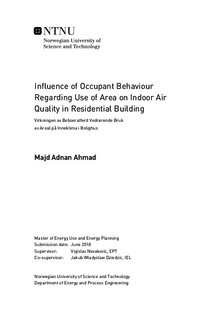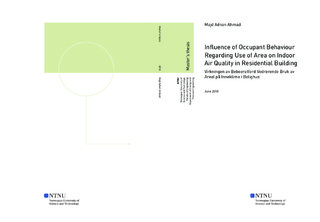| dc.description.abstract | Energy consumption in households stand for approximately 30% [1] of the total energy consumption in Norway, this is related to a number of factors, implying that energy use in buildings can also be optimized in various fields. Occupants behavior is considered to be one of the factors influencing the energy consumption as well as the indoor environment. However, the influence of occupants behavior is complex and hard to predict, thus under-recognized or over simplified in most cases. This thesis focus on the interaction between occupants and their surroundings in residential buildings, mainly on the issue of furniture settings. Increasing our knowledge about how the space and the equipment will be used by occupants, what their preferred device and furniture setting will influence the room condition in relation to temperature and air velocity.
The study takes place in an apartment located in Trondheim, Norway, more specifically the living room. Using a ventilation meter and thermal camera to perform a series of tests and measurements to gain information about the indoor environment, size of furniture and the rooms dimensions. Thereby adopting software such as Solidworks and ANSYS to recreate a geometrical representation of that selected room and preform a series of numerical CFD simulation based on these measurements. Various setting of the furniture is simulated (four to be exact), each one is different from the other but has the same boundary conditions.
Introducing Microsoft Kinect for occupant migration monitoring in the selected living room, conduct investigation regarding the thermal comfort sensation. This device was placed in the living rooms corner for almost a week, recording occupants movement throughout all four different room scenarios. Recorded data is obtained in form of clock data (Y/M/D/h/min/s) and point location (25 points in 3D [X, Y, Z]) distance from device [m]. [2]
Processed data from the Microsoft Kinect device demonstrated how the furniture setting had a noticeable influenced the occupant behavior (pattern). As it successful managed to detect occupant preferred furniture and place accordingly.
ANSYS numerical CFD simulation achieved 88-98% result accuracy, according to the set boundary conditions and method used. Several figures, charts, and tables are introduced in chapter 6, describing temperature, air velocity and air volume across all four selected room scenarios. Most of the results gathered from the CFD simulations support the idea that furniture settings could impact conviction flows in living room, even if its marginal. The person living in that apartment also mentioned that some room scenarios where more convenient than others, in terms of his mobility, access to other room furniture and air quality. His idea of a better room scenario also matched the one predicted by the CFD study. | |

